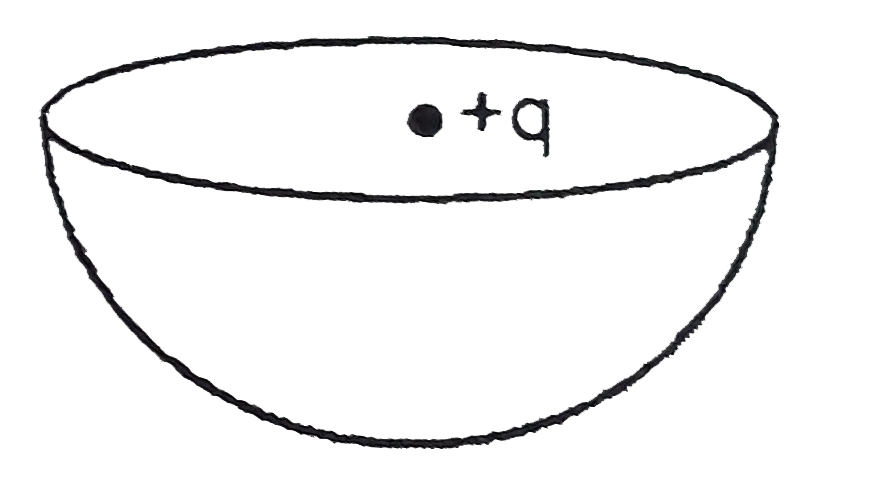Select the correct answer out of the options given against each question and write in the box provided on rigth hand side bottom:
+ q point charge is placed at the centre of a hemispherical surface . Amount of electrical flux crossing through the surface will be Solution in Bengali
qε0
q2ε0
q3ε0
2qε0
Considering all directions, the total flux around the point charge = qε0
The hemispherical surface surrounds half the entire space. So the flux through the surface = 12qε
Topper's Solved these Questions
- QUESTION PAPER OF WBCHSE 2019BOOK - CHHAYA PUBLICATIONCHAPTER - QUESTION PAPER OF WBCHSE 2019EXERCISE - PART- B (SECTION-II)
4 Videos
- QUESTION PAPER OF WBCHSE 2019BOOK - CHHAYA PUBLICATIONCHAPTER - QUESTION PAPER OF WBCHSE 2019EXERCISE - PART- B (SECTION-II)
4 Videos
- QUESTION PAPER OF NEET 2018BOOK - CHHAYA PUBLICATIONCHAPTER - QUESTION PAPER OF NEET 2018EXERCISE - QUESTIONS
58 Videos
- REFLECTION OF LIGHTBOOK - CHHAYA PUBLICATIONCHAPTER - REFLECTION OF LIGHTEXERCISE - INTEGER ANSWER TYPE
3 Videos
Similar Questions
Answer the question in one sentence each
(Alternatives are to be noted):
After what time will the direction of current in an electric supply line of frequency 50 Hz be reversed?
Or, Which physical quantity has unit Wb⋅m−2? Is it scalar or vector?
View SolutionAnswer the question in one sentence each
(Alternatives are to be noted):
After what time will the direction of current in an electric supply line of frequency 50 Hz be reversed?
Or, Which physical quantity has unit Wb⋅m−2? Is it scalar or vector?
View SolutionIt is found that if a neutron suffers an elastic collinear collision with deuterium at rest, fractional loss of its energy is pd, while for its similar collision with carbon nucleus at rest, fractional loss of energy is pc. The values of pd and pc are respectively
View SolutionThe image of an object placed at a distance of 40 cm from a convex mirror is formed at a distance of 10 cm from the mirror. If object approaches the mirror with a velocity of 32cm⋅s−1 , what will be the velocity of the image (incm⋅s−1)
View SolutionA point charge Q is placed at the centre of a hemisphere. Find the electric flux passing through flat surface of hemisphere.
View SolutionA point charge Q is placed at the centre of a hemisphere. Find the ratio of electric flux passing through curved andplane surface of the hemisphere.
View SolutionA point charge +q is placed at the centre of curvature of a hemisphere. Find flux through the hemispherical surface.

View SolutionA charge 'Q' is placed at the centre of a hemispherical surface of radius 'R'. The flux of electric field due to charge 'Q' through the surface of hemisphere is
View SolutionSelect the correct answer out of the options given against each question and write in the box provided on rigth hand side bottom: The dimension of electric potential is
View SolutionSelect the correct answer out of the options given against each question and write in the box provided on rigth hand side bottom:
A wire is stretched by 1% but volume remains constant, then
View SolutionSelect the correct answer out of the options given against each question and write in the box provided on rigth hand side bottom: The energy of an electron revolving around the nucleus of H-atom is -1.51 eV Angular momentum of this electron will be
View SolutionSelect the correct answer out of the options given against each question and write in the box provided on right hand side bottom: Angle of dip is 90^(@)N at
View SolutionSelect the correct answer out of the options given against each question and write in the box provided on right hand side bottom: The equation of an ac is i= 3sin omega t + 4 cos omegat. Then rms value of this current will be
View SolutionSelect the correct answer out of the options given against each question and write in the box provided on rigth hand side bottom: A biconvex lens behaves like a convergent in air but behaves like a divergent in water. Then refractive index (mu_(L)) of the lens will be
View SolutionSelect the correct answer out of the options given against each question and write in the box provided on rigth hand side bottom: The process in which the amplitude of the carrier wave is made proportional to the instantnaeous amplitude of the signal wave is called
View Solution
